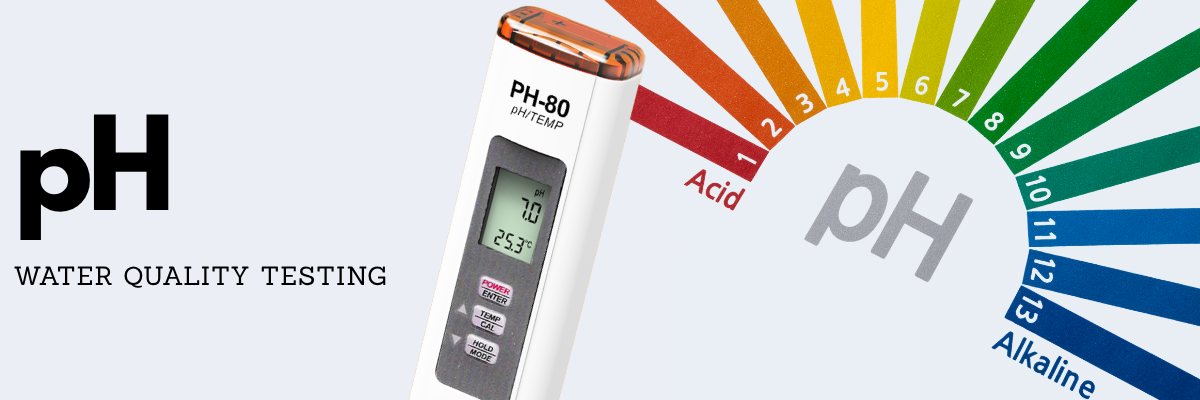Water is life, but not all water is the same.
One of the most important indicators of water quality is its pH level. Simply put, pH tells us whether water is acidic, neutral, or alkaline (basic). The pH scale ranges from 0 to 14, where:
- 7 is neutral
- Less than 7 is acidic
- More than 7 is basic or alkaline
Water that’s too acidic or too alkaline can cause serious issues — from damaging plumbing to harming plants, fish, and even human health.

Why pH Matters in Water Testing
You may not think about pH every day, but your coffee tasting weird, your plants not growing properly, or fish acting funny in the aquarium might all point to one thing: bad water pH.
In acidic water, metals like lead, copper, and iron can dissolve easily. This makes the water unsafe to drink or use, especially over time. On the flip side, alkaline water often contains excess calcium or minerals, leaving behind scaly deposits on utensils and giving a bitter taste.
That’s why pH in water testing is so crucial. It’s not just a number — it’s a signal.
pH in Drinking Water
Even though pH is technically an “aesthetic” factor (meaning there’s no legal limit), the EPA recommends a pH between 6.5 and 8.5 for drinking water.
Why? Because at a low pH, water can leach metals from old pipes or natural rock. That metallic taste? Could be iron. Reddish stains on clothes or sinks? Probably manganese. Worst of all, prolonged exposure to lead in acidic water can be toxic — especially for children.
Too alkaline, and your coffee gets weird, and you might notice a chalky residue in kettles or geysers.
pH in Groundwater: It’s Not Always Natural
Groundwater flows through rocks and soils that change its pH. For example:
- Sandstone gives a neutral pH (around 6.5–7.5)
- Limestone can raise pH up to 8.5 (very alkaline)
But it’s not just about geology. Pollution from coal or mining can lower the pH of groundwater to dangerous levels — as low as 2.0, which is extremely acidic.
Some agricultural practices also affect soil pH, which in turn impacts the water that seeps underground.
pH in Lakes, Streams & Aquariums
For those involved in aquaculture, fisheries, or even just maintaining a home aquarium, pH control is critical.
Most freshwater lakes, rivers, and streams have a pH of 6.0 to 8.0. Aquatic life, like fish, thrives in a pH range of 6.5 to 9.0. Go beyond that, and the water becomes either toxic or nutrient-overloaded, leading to plant overgrowth and low oxygen, which kills fish.
In agriculture, incorrect pH in irrigation water can lock out essential nutrients from crops, leading to poor yield. That’s why farmers rely on accurate pH meters to keep their soil and crops in check.
Using a pH Meter for Water Testing
Forget strips and guessing games. A pH meter is the gold standard for accurate water testing.
There are two main types:
-
Portable handheld pH meters for quick, on-site testing
-
Benchtop pH meters used in labs for high-precision readings
These devices use electrodes to detect the voltage difference in water, which is then converted into a pH value. They must be calibrated regularly to ensure accuracy.
Why use a pH meter?
Because you get faster, cleaner, and more reliable results than test strips or chemical kits.
Industries Where pH Testing is Essential
- Drinking Water Testing – For municipal supply, homes, and bottled water
- Agriculture & Hydroponics – Affects plant nutrient availability and soil balance
- Aquariums & Aquaculture – Ensures healthy aquatic ecosystems
- RO & Water Purification Systems – Monitors effectiveness and membrane health
- Industrial Wastewater Management – pH needs strict regulation before discharge
- Swimming Pools & Spas – Safety and comfort depend on balanced pH
Need Help Choosing the Right pH Meter?
Whether you’re managing a farm, a fish tank, a food lab, or your family’s drinking water — pH in water testing matters more than you might think.
It affects what you drink, what you grow, and what you keep alive.
Explore HM Digital’s range of TDS and pH meters — trusted by professionals in over 50 countries.
Whether it’s agriculture, RO water testing, or aquarium care, we’ve got a solution for you.


